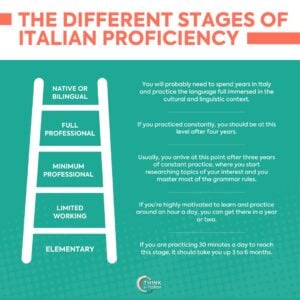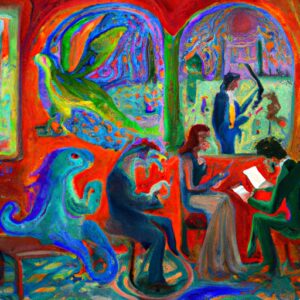Free Italian audio lessons
- Have you spent many hours reading, listening, or writing in Italian?
- Do you still find yourself hesitating in the middle of a sentence?
- Do you want to feel confident and fluent?
Then, put away your grammar books and start speaking now with an audio course focused on conversation skills!
Research shows that the most effective way to master Italian (or any other language) is through comprehensible input.
The news in Italian would make interesting material, but that’s too difficult for beginners.
That’s why I’m giving you a preview of these easy Italian language lessons.
Yes! That’s 10 free Italian lessons!
Online Italian course
Whenever I start learning a language, I speak it from day one. That could be with a native speaker on Skype or by myself with online lessons or audio courses.
If you’re learning Italian, you should check out our course.
Just so you know, a well-structured Italian language audio course should have the following characteristics:
- It should build your speaking confidence at a rapid pace;
- It should get you used to a native voice;
- It should challenge you throughout.
That’s why my audio course is great!
Learn Italian online with free audio lessons
These easy Italian language lessons contain sentences in English and Italian and are taken from the Italian audio course “Ripeti con me!”.
Each audio lesson covers a particular grammar pattern.
For example, there’s one lesson to learn singular and plural (one cat, two cats…), one lesson to learn how to say “can” (I can speak, you can eat…), etc.
It also repeats useful vocabulary on the way.
While this preview showcases the concept and the program of the course, you start to feel the effects – thinking and speaking naturally in Italian – only after a few days of taking the full lessons (each made up of 30 sentences).
And now, it’s time to learn!
There are 3 files for each lesson. You can download them and listen to them, like the best podcast to learn Italian.
However, passive listening won’t work. You need to repeat what you hear!
Click on the audio player in each lesson to listen to the audio and speak along with the speaker.
You can also download free Italian lessons in mp3 format.
It’s an excellent way to learn Italian while driving.
Now, let’s learn how to speak Italian for free.
How to use these free Italian audio lessons
Here’s a quick step-by-step guide on how to use these free Italian audio lessons:
- In File A, you listen to a sentence in English and Italian, then shadow the Italian sentence (saying the same sentence while the speaker is still saying it).
- In File B, there’s a pause where you’re meant to say the sentence yourself in Italian. It’s alright if you can’t remember everything; just do your best and say what you can. Then, you can shadow it again.
- In File C, you only shadow the sentence.
This material is useful only if you repeat what you hear. That’s how you make your learning experience active.
Passive listening to resources like courses or podcasts has never made anyone fluent in languages.
If you take these lessons in a series, you’ll learn to speak Italian for free.
Free Italian audio lessons
Let’s now get started with some Italian audio lessons.
Make sure you listen to the way I just told you.
Free Italian audio lesson 1: sei italiano?
In this free Italian lesson, you’ll learn how to say “I am…” in Italian!
More precisely, you’ll hear the following dialogue:
Are you Italian?
Sei italiano?
No, I’m from the U.S.
No, sono americano.
What’s your name?
Come ti chiami?
Listen and repeat file A:
Listen and repeat file B:
Listen and repeat file C:
Confused? Check out these grammar notes on the verb essere.
Free Italian audio lesson 2: ho sete!
Learn how to say “I have…” in Italian!
Here’s the dialogue you’ll hear:
Do you have any brothers or sisters?
Hai fratelli o sorelle?
Yes, I have a brother.
Sì, ho un fratello.
Do you have the keys to the house?
Yes.
Hai le chiavi di casa?
Sì.
Listen and repeat file A:
Listen and repeat file B:
Listen and repeat file C:
Still confused? Check out these grammar notes on the verb avere.
Free Italian audio lesson 3: un gelato, due gelati
One beer or two beers? Learn how to make words plural in Italian with the following dialogue:
I’d like a small beer.
Vorrei una birra piccola.
For me, mineral water!
Per me acqua minerale!
For us, French fries!
Per noi patatine fritte!
Listen and repeat file A:
Listen and repeat file B:
Listen and repeat file C:
Still have doubts? Check out these grammar notes in the plural form.
Free Italian audio lesson 4: un bambino, una bambina
Is that a he or a she? Learn how to make words masculine and feminine in Italian!
Here’s the dialogue:
Do you have children?
Avete bambini?
We have a girl.
Abbiamo una bambina.
Alessia is a good friend.
Alessia è una buona amica.
Listen and repeat file A:
Listen and repeat file B:
Listen and repeat file C:
Need more grammar notes? Learn more about the gender of Italian nouns and adjectives.
Free Italian audio lesson 5: la vita è bella
There’s only one “the” in English, but there are many equivalents of “the” in Italian. Learn how to pick the right one!
That’s the end!
È la fine!
Life is beautiful.
La vita è bella.
That’s just the beginning!
È solo l’inizio!
Listen and repeat file A:
Listen and repeat file B:
Listen and repeat file C:
The best way to learn Italian! Listen and repeat!
Want to know all the grammar rules? Learn more about the definite articles in Italian.
Free Italian audio lesson 6: ho un’idea!
You might get by with only “a” and “an” in English, but there are many in Italian. Learn how to pick the right one!
Do you have a phone?
Hai un telefono?
5 euros for a gelato!?
Cinque euro per un gelato!?
That’s good news.
È una bella notizia.
Listen and repeat file A:
Listen and repeat file B:
Listen and repeat file C:
Need to know all the grammar rules? Learn more about the indefinite articles in Italian.
Free Italian audio lesson 7: dove lavori?
Forget about conjugation tables! Learn Italian with audio!
Learn the present tense of Italian verbs naturally with these sentences. Remember listening alone is not enough. You should repeat everything!
Where do you work?
I work in an office.
Dove lavori?
Lavoro in ufficio.
What do you have for breakfast?
I eat an apple.
Cosa mangi a colazione?
Mangio una mela.
Do you have any children?
Yes, I have a daughter.
Hai figli?
Sì, ho una figlia.
Listen and repeat file A:
Listen and repeat file B:
Listen and repeat file C:
Crazy about verb conjugations? Learn more about the present tense of regular Italian verbs.
Free Italian audio lesson 8: dove vai?
Even if some Italian verbs are irregular, you can still learn them without conjugation tables! Here are the sentences:
I’m hungry. When are we going to eat?
Ho fame! Quando mangiamo?
Where are you going?
I’m going to the bank. Bye!
Dove vai?
Vado in banca. Ciao!
What books do you read?
I read novels.
Che libri leggi?
Leggo romanzi.
Listen and repeat file A:
Listen and repeat file B:
Listen and repeat file C:
Crazy about irregular verb conjugations? Learn more about the present tense of irregular Italian verbs.
Free Italian audio lesson 9: a Roma
These sentences show when we use “a” and when we use “in” to talk about a place:
Where are you going?
Home.
Dove vai?
A casa.
Where do you live?
In Rome.
Dove abiti?
A Roma.
Hello? Where are you?
In the bathroom.
Pronto? Dove sei?
In bagno.
Listen and repeat file A:
Listen and repeat file B:
Listen and repeat file C:
Still confused? Find more about the prepositions in and a.
Free Italian audio lesson 10: studi ancora francese?
Learn how to turn a statement into a question in Italian!
Spoiler: just change the intonation.
We’ve got important news!
Abbiamo una notizia importante!
Do you have any news from Lucia?
Avete notizie di Lucia?
Do you still work in a pharmacy?
Lavori ancora in farmacia?
Listen and repeat file A:
Listen and repeat file B:
Listen and repeat file C:
Try our Italian audio course!
Now that you’ve listened to the first 10 free Italian lessons… do you like how these easy Italian language lessons work?
Do you want more Italian lessons in audio?
Find the full course here!
Online Italian course to learn Italian fast
“Ripeti Con Me!” is a uniquely effective course that teaches its users how to use a foreign language. It doesn’t just spit out vocabulary and grammar.
You’ll learn whole phrases and entire sentences so that you can learn the language in context, instead of learning words or grammar rules in isolation.
Language learning needs Italian lessons audio with context!
It’s perfect if you’re looking for a practical way to improve your ability to create correct sentences in Italian on the fly and speak Italian in a natural way.
This collection of easy Italian audio lessons is so natural that you may find it hard to believe that something so simple could work so well!
Ripeti Con Me functions as a language learning gym.
The entire program is built on top of a scientifically proven set of principles designed to take a learner directly to the heart of the language.
What’s the methodology behind this online Italian course?
This method is based on a few key principles:
Graduated interval recall
If you’re reminded of new words at gradually increasing intervals, each time you remember for a longer amount of time compared to the time before.
This method is called spaced repetition or graduated interval recall.
Teaching syntax over vocabulary
Most language courses focus on teaching a mixture of grammar and vocabulary, while this course is based on syntax.
Have you ever invested a ton of time and energy into learning the grammar and vocabulary of a language, only to struggle to create intelligible sentences?
While grammar and vocabulary are important when you’re learning a language, it’s knowing how to use both of these elements to create a correct sentence that really unlocks your Italian conversational abilities.
Principle of Anticipation
By systematically asking for understanding, pausing for a response, and then reinforcing the correct response, the audio in Ripeti Con Me accelerates learning, increases understanding, and activates new neural pathways in your brain.
Practical approach
The program’s focus on teaching syntax makes it ideal for increasing your ability to have conversations in a foreign language.
If you work through the training sessions daily as they were designed, you will gain a practical working knowledge of the Italian language.
You will see improvement in your language abilities where they matter most: in real-life conversations.
Core Vocabulary
Effective communication in any language depends on the mastery of a relatively limited number of common Italian words and structures like Italian numbers.
Trying to learn too much at once substantially slows the process, and many people quickly become discouraged.
Ripeti Con Me deliberately limits the amount you learn at any one time, giving your brain a chance to internalize each new item before moving on.
Once this foundation is built, adding new words and phrases becomes easy and natural because there’s a clear framework to attach them to.
Organic Learning
Every new item introduced Ripeti Con Me is given within the context of a conversation or exchange.
This helps learning and retention in a multitude of ways, from allowing your brain to automatically integrate Italian intonation, rhythm, melody, and pronunciation, to embedding, prompts for your memory.
When you need a word, it’s there!
Italian lessons audio for free
So, you want to learn Italian for free?
Well… you can learn Italian with free audio lessons!
There’s plenty of resources to learn languages: podcasts for listening, grammar books, vocabulary lists to download, online courses. They’re all useful in some way.
However, listening passively to a podcast won’t make you fluent. Reading a book won’t improve your speaking skills.
Stuffing vocabulary in your head won’t make you able to actually use it in conversation.
Language learning needs practice.
So, if you liked these free Italian lessons and find them useful, download the Italian audio course “Ripeti con me!” and practice listening and speaking for real!
There’s even a lesson about Italian swear words!
Start a free trial now!
If you still want free resources for listening to download, check out the free online resources (podcasts):
To enhance your focus throughout a lesson, try nootropics for studying languages.



















